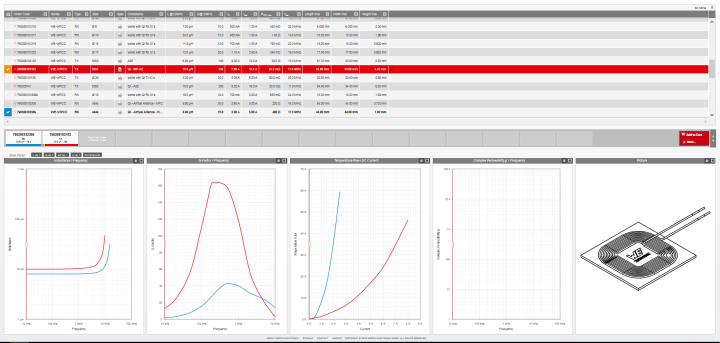Review: Würth Elektronik Red Expert
The term “Power Stage Design Tools” on the screen I personally interpret as also encompassing audio and RF power amplifiers but it does not, at least not directly. Clicking on it however quickly got me back on solid ground with the next screen showing the familiar elementary schematics of DC-DC converters with special attention given to the inductor (notice the coupled ones in the SEPIC topology). One of Würth’s most promoted and widely applauded tools, the Loss Calculation for Power Inductors, can be accessed there.

Another one I circled in red for interest is the Resonance Tank Calculation. I did find this more of a selection tool than a true design or engineering helper though, as the graphs present the key parameters of one or more Würth inductors you select first based on one of your initial criteria, for example, the Q factor. It does work very well and you can immediate see the trade-offs, if any, you may have to accept for the other three parameters (TANSTAFL principle).

The graphs are updated quasi instantly with a different colour for each inductor selected and you can put the cursor at any point on the lines to make discrete values pop up— now if that doesn’t beat the electronics textbook and the calculator… On the down side, the all-graphical method obscures the underlying theory of inductor coupling at resonance which helps to provide a true understanding of the mechanism. But then we have the Trilogy ready on the bookshelf for consulting under lamplight. Here, the advantage of Red Expert boils down to speed, i.e. almost instantaneous results, not forgetting the ability to export files to convince the Chief Technology Officer in your company. Or write your research report. Or understand the crappiness and/or EMI emission levels of a Chinese made power supply for an LED string or a cheap laptop.

Another one I circled in red for interest is the Resonance Tank Calculation. I did find this more of a selection tool than a true design or engineering helper though, as the graphs present the key parameters of one or more Würth inductors you select first based on one of your initial criteria, for example, the Q factor. It does work very well and you can immediate see the trade-offs, if any, you may have to accept for the other three parameters (TANSTAFL principle).

The graphs are updated quasi instantly with a different colour for each inductor selected and you can put the cursor at any point on the lines to make discrete values pop up— now if that doesn’t beat the electronics textbook and the calculator… On the down side, the all-graphical method obscures the underlying theory of inductor coupling at resonance which helps to provide a true understanding of the mechanism. But then we have the Trilogy ready on the bookshelf for consulting under lamplight. Here, the advantage of Red Expert boils down to speed, i.e. almost instantaneous results, not forgetting the ability to export files to convince the Chief Technology Officer in your company. Or write your research report. Or understand the crappiness and/or EMI emission levels of a Chinese made power supply for an LED string or a cheap laptop.
Read full article
Hide full article


Discussion (0 comments)